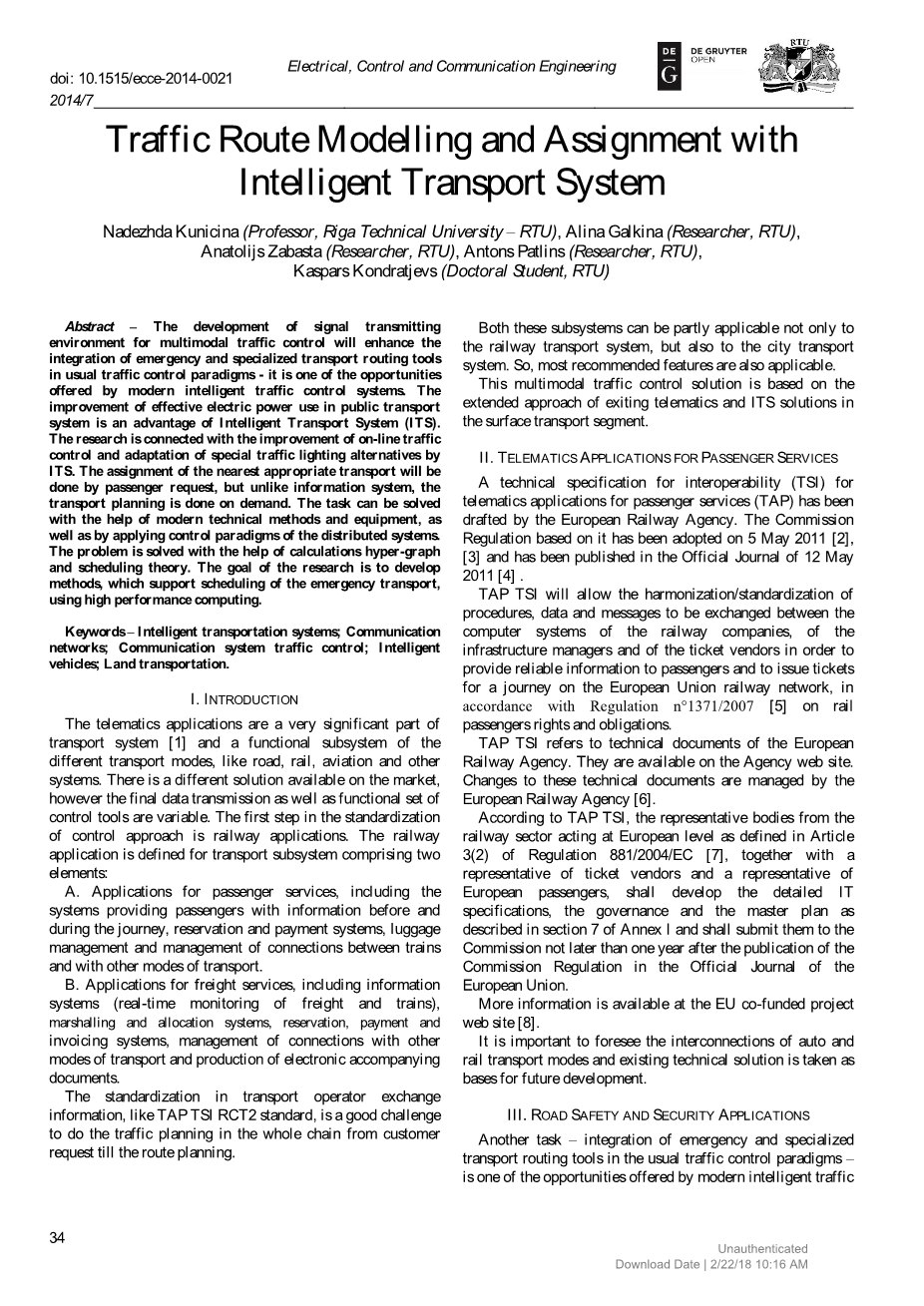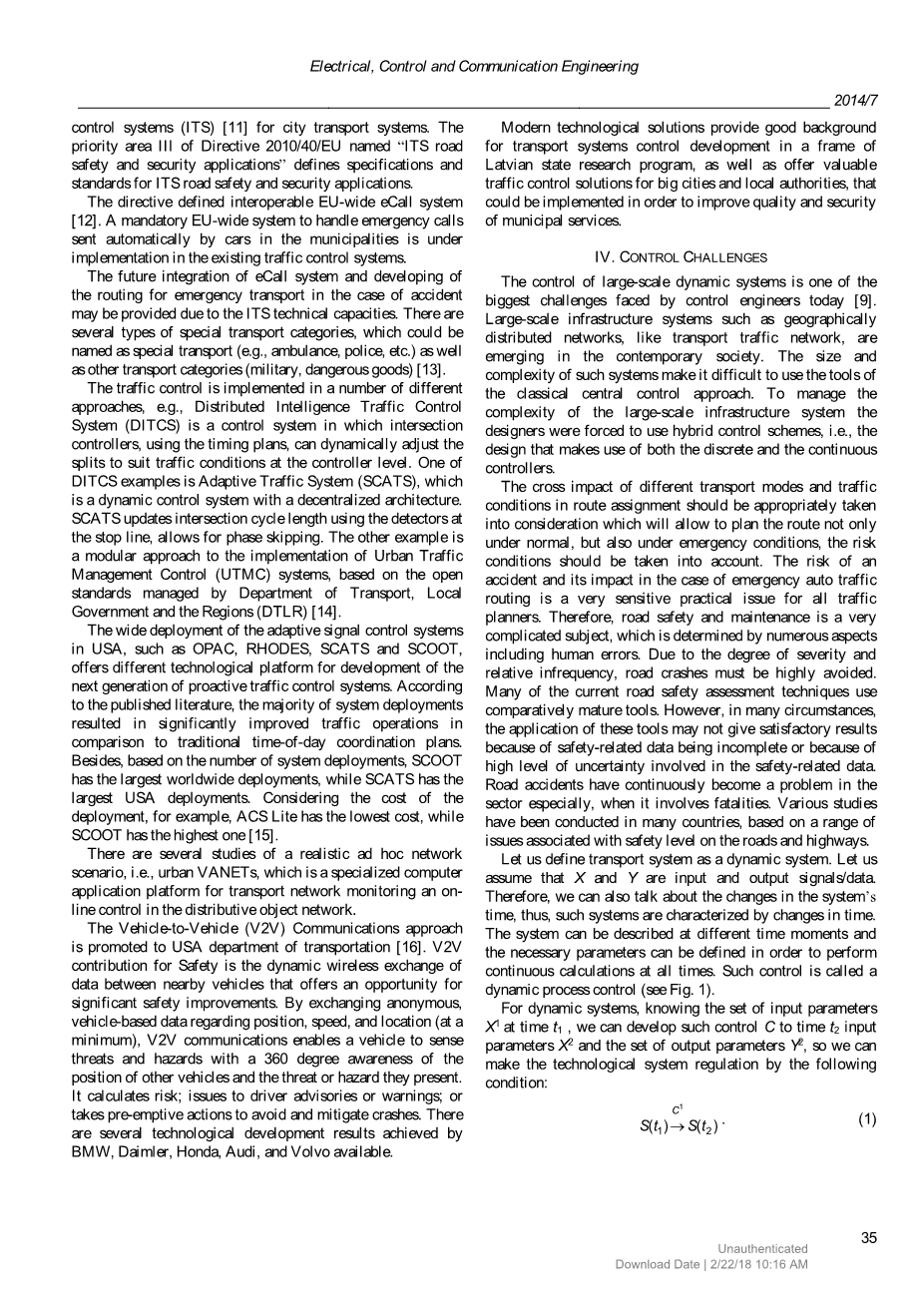

英语原文共 7 页,剩余内容已隐藏,支付完成后下载完整资料
原文
Traffic Route Modelling and Assignment with Intelligent Transport System
Nadezhda Kunicina (Professor, Riga Technical University – RTU),
Alina Galkina (Researcher, RTU),
Anatolijs Zabasta (Researcher, RTU),
Antons Patlins (Researcher, RTU),
Kaspars Kondratjevs (Doctoral Student, RTU)
Abstract – The development of signal transmitting environment for multimodal traffic control will enhance the integration of emergency and specialized transport routing tools in usual traffic control paradigms - it is one of the opportunities offered by modern intelligent traffic control systems. The improvement of effective electric power use in public transport system is an advantage of Intelligent Transport System (ITS). The research is connected with the improvement of on-line traffic control and adaptation of special traffic lighting alternatives by ITS. The assignment of the nearest appropriate transport will be done by passenger request, but unlike information system, the transport planning is done on demand. The task can be solved with the help of modern technical methods and equipment, as well as by applying control paradigms of the distributed systems. The problem is solved with the help of calculations hyper-graph and scheduling theory. The goal of the research is to develop methods, which support scheduling of the emergency transport, using high performance computing.
Keywords – Intelligent transportation systems; Communication networks; Communication system traffic control; Intelligent vehicles; Land transportation.
I. INTRODUCTION
The telematics applications are a very significant part of transport system [1] and a functional subsystem of the different transport modes, like road, rail, aviation and other systems. There is a different solution available on the market, however the final data transmission as well as functional set of control tools are variable. The first step in the standardization of control approach is railway applications. The railway application is defined for transport subsystem comprising two elements:
- Applications for passenger services, including the systems providing passengers with information before and during the journey, reservation and payment systems, luggage management and management of connections between trains and with other modes of transport.
- Applications for freight services, including information systems (real-time monitoring of freight and trains), marshalling and allocation systems, reservation, payment and invoicing systems, management of connections with other modes of transport and production of electronic accompanying documents.
The standardization in transport operator exchange information, like TAP TSI RCT2 standard, is a good challenge to do the traffic planning in the whole chain from customer request till the route planning.
Both these subsystems can be partly applicable not only to the railway transport system, but also to the city transport system. So, most recommended features are also applicable.
This multimodal traffic control solution is based on the extended approach of exiting telematics and ITS solutions in the surface transport segment.
II. TELEMATICS APPLICATIONS FOR PASSENGER SERVICES
A technical specification for interoperability (TSI) for telematics applications for passenger services (TAP) has been drafted by the European Railway Agency. The Commission Regulation based on it has been adopted on 5 May 2011 [2], [3] and has been published in the Official Journal of 12 May 2011 [4] .
TAP TSI will allow the harmonization/standardization of procedures, data and messages to be exchanged between the computer systems of the railway companies, of the infrastructure managers and of the ticket vendors in order to provide reliable information to passengers and to issue tickets for a journey on the European Union railway network, in accordance with Regulation n°1371/2007 [5] on rail passengers rights and obligations.
TAP TSI refers to technical documents of the European Railway Agency. They are available on the Agency web site. Changes to these technical documents are managed by the European Railway Agency [6].
According to TAP TSI, the representative bodies from the railway sector acting at European level as defined in Article 3(2) of Regulation 881/2004/EC [7], together with a representative of ticket vendors and a representative of European passengers, shall develop the detailed IT specifications, the governance and the master plan as described in section 7 of Annex I and shall submit them to the Commission not later than one year after the publication of the Commission Regulation in the Official Journal of the European Union.
More information is available at the EU co-funded project web site [8].
It is important to foresee the interconnections of auto and rail transport modes and existing technical solution is taken as bases for future development.
III. ROAD SAFETY AND SECURITY APPLICATIONS
Another task – integration of emergency and specialized transport routing tools in the usual traffic control paradigms – is one of the opportunities offered by modern intelligent traffic control systems (ITS) [11] for city transport systems. The priority area III of Directive 2010/40/EU named “ITS road safety and security applications” defines specifications and standards for ITS road safety and security applications.
The directive defined interoperable EU-wide eCall system [12]. A mandatory EU-wide system to handle emergency calls sent automatically by cars in the municipalities is under implementation in the existing traffic control s
全文共34082字,剩余内容已隐藏,支付完成后下载完整资料
资料编号:[8963],资料为PDF文档或Word文档,PDF文档可免费转换为Word


